|
FAQs About Dojos, Weatherfishes
Health/Disease 3
Related Articles: Dojo Use
in Ornamental Ponds, Loaches,
A New Look At
Loaches By Neale Monks,
Related FAQs: Dojos/Weatherfishes Health 1,
Dojo Health 2, Dojo Health 4,
Dojo Health 5, Dojo/Weatherfishes 1,
Dojos/Weatherfishes 2, & FAQs on:
Dojos/Weatherfishes Identification,
Dojos/Weatherfishes Behavior,
Dojos/Weatherfishes Compatibility,
Dojos/Weatherfishes Stocking/Selection,
Dojos/Weatherfishes Systems,
Dojos/Weatherfishes Feeding,
Dojos/Weatherfishes Reproduction, &
Loaches 1,
Clown Loaches, &
Loach Identification,
Loach Behavior,
Loach Compatibility,
Loach Selection,
Loach Systems,
Loach Feeding,
Loach Disease,
Loach Reproduction,
|
|
|
Weather Loach w/Bumps 9/16/17
Hi!
<Hello Wendy,>
Your wonderful website has helped me before so I'm hopeful you can give me some
pointers.
<Sure.>
Ghosty (pictured below), approx 5" & 3 yrs old; 55 gal tank; co-habits w/other
loaches Jake 7", Jr 4" & Tiny 2", 1 angel fish, 3 zebra Danios & a 2" Pleco.
Water parameters as of this am are Amm 0, Nitrites 0 & Nitrates .25. Now that
they are in the 55 gal vs. a 10 gal, it's much easier to keep the tank healthy.
<Sounds fine, though do believe Nitrate is 25, not 0.25, which would be
unmeasurable with typical test kits.>
Over the last week, I've noticed Ghosty not eating as much, and about 3 days
post onset of eating behavior change, I noticed lumps appearing on top side of
back very near tail fin. I have noticed what looks like slime film
floating in tank & his dorsal & tail fins aren't clear, they seem somewhat
cloudy or slimy looking.
<I see this.>
He seems to swim & act normally otherwise. All other fish appear healthy & not
affected by whatever is going on with him.
<Indeed.>
After today's cleaning, I added Stress Zyme & Vita Chem to tank in hopes of
boosting his health.
<Neither of these "cure-alls" does much. Stress Zyme is all but redundant in a
properly maintained aquarium, while Vita Chem is a vitamin supplement, but just
as with humans, assuming a balanced diet, basically pointless.>
Standard PWC includes Prime & Stability by SeaChem.
<Much more useful products.>
Any ideas? Thanks in advance!
<In the short term, I'd observe. But I'd consider three things. One, physical
damage. I'm not a huge fan of gravel substrates with Weather Loaches, because
gravel tends to damage them, leading to skin damage and bacterial infections.
Anti-Finrot medication can undo the damage, but do check the gravel isn't sharp,
and also that there aren't any objects likely to have caused such damage, like
jagged rocks. Cloudy fins are a classic indicator of incipient Finrot, which is
another pointer in this direction.
Avoid copper and formalin where loaches are concerned, but antibiotics and
products such as eSHa 2000 should be fine. The second is diet. Deformities of
the spine and fins can indicate malnutrition, which while unlikely with
fish that have hearty appetites, is certainly possible if you rely heavily on
one or two types of frozen or fresh foods rather than optimally balanced pellets
and wafers. Finally, there is so-called Slime Disease caused by
various parasites of the genus Ichthyobodo, sometimes known as Costia in older
aquarium books. Slime Disease manifests itself as increased slime production,
often distinctive lumps of the stuff, as well as clamped fins,
lack of appetite, and over time, wasting and death. It's tricky to deal with,
but commercial medications are available. One last thing to bear in mind is that
Weather Loaches are subtropical fish -- constantly maintaining
them at tropical temperatures is probably not ideal, and will shorten their
lives appreciably.>
Wendy
<Cheers, Neale.>
|
.jpg)
.jpg) |
|
Re: Weather Loach w/Bumps 9/16/17
Hi Neale,
Thanks so much for getting back to me so quickly!
<Welcome.>
You’re right, it’s 25 ppm with my liquid testing kit.
<A-ha!>
Would you advise treating for both Fin Rot & Slime Disease? Is there a product
available in US which you recommend for treating both? If not advisable to treat
both at the same time, which would you treat first and how much time would you
give it before I treat the other?
<I would try to determine which was most likely given the symptoms. Normally
Finrot appears on the fins first, usually as pink or white blotches, followed by
eroding fin tissue. Of course if Finrot sets in on wounds on the body, you can
certainly have a situation where the fins are fine but you see white, rotting
tissue around the wound. Slime Disease is not particularly associated with
wounds or fins, but rather expanses of excessive slime on the body. There may be
an off-white to grey colouration over the background colour. Listlessness and
wasting may be associated with Slime Disease. Your retailer may have some
products that work against both, but if not, choose something for Costia, and
simply run an antibiotic alongside it for the Finrot. This combo should be safe,
though as noted before, avoid copper and formalin, both of which are
particularly toxic to loaches.>
Are the other fish susceptible to whatever’s ailing Ghosty & thus should I treat
the 55 gal tank (assuming yes if parasitic but no if bacterial due to injury,
except other loaches at risk of same if they get injured on pea gravel)?
<Costia can be contagious, but seems to "pop up" when fish are stressed. So
while you could medicate the tank, if a hospital tank is available, and the
other fish seem fine, then by all means remove the infected fish. Finrot is not
contagious as such, and fish suffering Finrot can be treated separately if
necessary.>
Or move him to the 10 gal tank (currently populated with 5 guppies, an angel
fish & 2” Pleco) & treat Ghosty with antibiotics there? I suppose I could move
all occupants of the 10 gal to the 55 gal thus making the 10 gal a hospital
tank, but I fear Ghosty would become lonely by himself, which would not help him
recover any quicker.
<Quite so.>
I have not looked into better foods for the loaches but will do so, I would hate
to think they are not receiving adequate nutrition. They do love frozen peas as
a treat but I typically just feed a pinch of Tetra Tropical Crisps and Omega One
Shrimp pellets (3-4, every other day or so). I have followed your advice from 2
years ago to err on the underfeeding side vs. the overfeeding side. Any US
recommendations for food would be much appreciated.
<I do think your range of foods, including greens, is probably fine. The
problems occur when people use just one thing, like bloodworms, which have a
poor nutritional profile.>
The water temp is kept around 75 degrees - not sure how to make it cooler than
that as tank is on my main floor & Kansas does get fairly hot in the summer. I
can keep it much cooler in the other seasons - down to about 65 if the angel
fish can handle that.
<Understood. I would keep the heater on (your Angels will suffer below 22 C/72
F) but avoid anything above 25 C/77 F as that'll be well above the comfort zone
of these loaches.>
Thanks again!
Wendy
<No problem! Cheers, Neale.>
Re: Weather Loach w/Bumps 9/16/17
Great, thank you SO much Neale!
<You are most welcome!>
Re: Weather Loach w/Bumps 9/17/17
Morning!
After researching, I have decided on either API TC Tetracycline or Seachem
Paraguard. Do you have any preference or experience with either product?
Paraguard seems like a “safer” or less harsh treatment but I have no experience
with either, so thought I would ask for your expertise. Thank you so much for
your help! :)
<Hi Wendy. Seachem Paraguard does not contain an antibiotic, so is a less
specific medication. So Seachem Paraguard is probably a good "first pass"
medication if you're not sure what the story is, but the fish isn't in bad
shape. Antibiotics are more limited, only dealing with bacterial infections, but
they are far more effective at treating such diseases than anything else. This
makes antibiotics much the best choice if the fish is in a serious state and/or
you're 100% sure you're dealing with a bacterial infection. Make sense? They're
both good products, just different! Cheers, Neale.>
|
Re Dojo Tail Difference - 09/22/17
Hi Again,
<Wendy>
I did pick up on a difference in his tail fin however. The top pic was
pre-treatment, & the bottom one is after 4 doses of Furan-2. Today marks 7 days
after the 1st dose was administered.
<Mmm>
I can't tell if the pointy bit of fin in the bottom pic is getting ready to fall
off, or if his fin has regrown something that had been missing?
<Will share with Neale. I can't tell. Bob Fenner>
Wendy
|
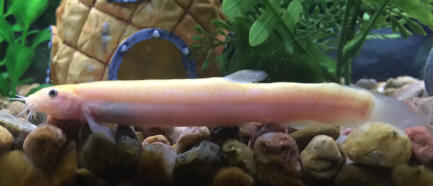
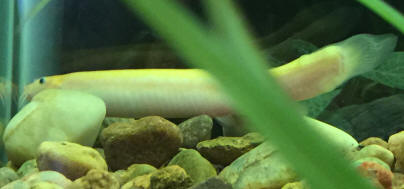 |
|
Tail Difference 9/23/17
Hi Again,
I did pick up on a difference in his tail fin however. The top pic was
pre-treatment, & the bottom one is after 4 doses of Furan-2. Today marks 7 days
after the 1st dose was administered.
I can't tell if the pointy bit of fin in the bottom pic is getting ready to fall
off, or if his fin has regrown something that had been missing?
Wendy ��
<Oh, this looks like regrowth to me; while the thicker white rays are probably
deformed bones (which may heal in time) the absence of fin material like
'cobwebs' between exposed fin rays is promising. Still, I'd keep a close eye on
this chap over the next week or two. Do look for pinkish inflammation indicative
of congested blood vessels -- often the first sign of incipient Finrot. Cheers,
Neale.>
Ghosty the Loach 9/23/17
Hi Neale!
Just thought I'd send an update on Ghosty, whom we think may have either fin rot
or slime disease. I treated the entire tank with 4 doses of Furan-2, since after
doing a lot more research, this seemed to be the medication that was most
recommended for those two issues. We are now 7 days past the first Furan-2 dose
& his fins are not in appreciably better condition than pre-treatment, and the
bumps near his tail have remained the same. He is eating better though, & acting
normal otherwise. The slime shedding has decreased significantly.
I would be very appreciative of what you would recommend my next steps to be.
Thank you for your advice! :)
Wendy ��
<Hello Wendy. I'd no nothing beyond observation. Antibiotics are often all
that's needed to start the road to recovery -- thereafter good water quality,
optimised diet, and temperatures towards the warmer end of the preferred range
are all you need for the fish to get 100% better. Good luck! Neale.>
|
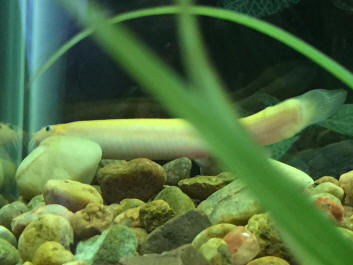 |
Re: Ghosty the Loach
10/9/17
Hi there!
<Wendy,>
Just thought I’d give an update on Ghosty as things have been going fine since
the end of Furan-2 treatment (final of 4th doses given Sept. 19 with 25% water
change on 9/20, carbon filter added back into the tank on 9/23). Ghosty’s fins
all began to look much clearer about mid-treatment, and I was really hoping that
would have been the fix he needed.
<Quite so.>
However, on 10/4 I began to notice his fins looking cloudy again, and another
loach named Jake has a very slightly ragged dorsal fin & tail fin now. :-/ Water
parameters are pristine with nitrate being kept at 20-40 ppm as I am very
consistent with PWC. Ammonia is 0 as are nitrites. Temp in the tank fluctuates
with ambient room temp of 72-76 as the tank is on the main level of our home.
<Understood. I would ensure a heater is in the tank, maybe set to 25 C/77 F
while medicating. Even for coldwater fish, steady warmth can be beneficial while
they're immune systems are working hard. By all means turn it down once the fish
are healed, but short term, I'd offer steady warmth.>
I have both Furan-2 and T.C. Tetracycline on hand so I could do either one
immediately; am just wondering if a fungal treatment would be more prudent now?
<Only if you suspect fungus; scattergun approaches to medication are no more
effective with fish than they are with humans. On the other hand, repeatedly
dosing antibiotics may be necessary when medicating against persistent bacterial
infections or in situations where some stress factor is causing the bacteria to
regain their foothold even after being knocked back successfully.>
All the fish are eating & acting normally but I really don’t like the look of
Ghosty & Jake’s fins. All the other fish are looking great, in fact the 3 Danios
are once again looking vibrant & beautiful now, whereas before their color was
faded (combination of better water conditions and Furan-2 or water alone?).
<Perhaps a little from column A, a little from column B...>
There are two other loaches in this tank & so far their fins are clear & intact,
nothing looking off to them as far as I can see.
<Good.>
Thank you again for all your help! I really appreciate it!
Wendy
<Most welcome. Neale.>
Re: Ghosty the Loach 10/11/17
Thanks Neale!
<Welcome.>
I will turn up the heater while treating then.
<Good-oh.>
I have never had any experience w/fungal infections so I honestly don’t know
whether it would be better to only turn up the heat a bit to 77 as suggested &
watch & wait, or also dose with Furan-2 since his fins did indeed respond
quickly to that treatment.
<I'd up the temperature, and use the antibiotics again, especially if they
worked once already. As stated earlier: there's no reason to assume a single
course of antibiotic will do the trick with resistant strains of bacteria, any
more than is the case with humans. A second or third course may be required.>
If he were yours, what would you do?
<See above.>
Thank you again!
Wendy
<Cheers, Neale.>
Re: Ghosty the Loach 10/11/17
Awesome! Will do. Temp to 76 now & will commence antibiotics. Thank you again!
Wendy
<Most welcome and good luck! Cheers, Neale.>
|
|
Maybe Not Really Algae; Misgurnis dis.
9/3/17
Hello WWM Crew!
<Hello Renee,>
This is Renee, in Idaho with the human remains in the water!
<Eh?>
Haven’t written to you for a while, and I hope you are all well, but everything
here is going great! The BGK is healthy, happy, and almost 6 inches long now!
The Elephant Nose has filled out nicely, is eating well, and has turned out to
be a gregarious little charmer!
<All sounds like good news.>
I even “inherited” a Baby Whale (completely separate tanks from both the
Elephant Nose and the BGK {who are also in separate tanks from each other}) who
is turning out to be a really fun little fish! We had a little “bump in the
road” in the loach tank earlier this week (see attached picture), but I took
this same picture down to my aquarium store, they sold me some Kanaplex which
took care of the problem completely in 24 hours (I still have one more treatment
to give, but the fish were clear 24 hours after the first dose). But something
unforeseen happened after the first treatment and it is that event I wanted to
ask you about.
This all took place in my 125 gallon which houses 7 Weather Loaches and 6 SAE’s
(the SAE’s did not get whatever this white stuff was – just the loaches).
<It looks like Slime Disease, also known as Costia.>
Its been up and cycled for 2 years now. That is significant because
this tank was in operation before I found out about the .5 – 1 ppm of ammonia
and the human remains in my tap water. I changed the substrate when I switched
to the RO water, but the tank, ornaments, filter, and powerheads, were all
exposed to the creepy, nasty, water from my well. When I changed over to the
RO/DI water, I did it incrementally so as not to destroy the biological filter
in the tank. Regardless, for the last year, I have been battling a nasty algae
that sprung up and covered the ornaments and the back wall (and only the back
wall) of the tank. Originally, it was the long black hairy looking algae, hence
the SAE’s who took care of that promptly. But a blackish green algae remained
(you can kind of see it in the background of the picture of the sick fish),
again, only on the ornaments and back wall. But the SAE’s wouldn’t touch it. I
tried putting one of my Bristlenose in for a while, but I never saw it go near
that back wall.
<Black slime on an aquarium is almost certainly algae. If it has a distinctive
musty smell, chances are that it's Cyanobacteria. If you have a hand lens or
microscope, you can look at it, and often see it has a fine, matted, thread-like
texture even though it looks glossy and sheet-like. Red algae, which can be
black, turns red when left in clear alcohol (hence the same, and yes, vodka
should work) has a coarser tufty texture in most cases and other than a watery
smell, doesn't normally smell of anything.>
So I’ve been scrubbing that stuff weekly ever since without much success. I
mean, this stuff is tough – I scrub with a fairly aggressive plastic pad as well
as an algae scraper from my aquarium store and I have to scrub very hard for
what seems like forever to even put a dent in this stuff. Well, the Kanaplex
that I used to treat the loaches is killing this stuff (I don’t call it algae,
even though that’s what it looked like, because I no longer believe that’s what
it was).
<Antibiotics can, do kill Cyanobacteria.>
After the first dose, ¾’s of it was gone. After the second treatment, all that’s
left is a few patches here and there. And it’s NOT floating loose and creating a
green cloud in the water like it does when I try to scrub it, it’s just gone
(YEAY!)! I’ve been researching and the stuff that comes closest to what I had
was the Cyanobacteria – but still not quite the same. The pictures I saw of the
Cyano showed the stuff covering ONLY the floor and ornaments in the tank, not
the glass walls at all.
<There are of course various kinds. In my experience Cyanobacteria tends to be
promoted by a number of things: slow water movement, direct sunlight, high
temperature spikes during the day, and infrequent water changes that allow
nitrate to stay consistently high.>
The stuff I had covered the back wall harder than cement, but only the back wall
and the ornaments. Maybe that means nothing, I don’t know.
<Oh, it often is significant. Sand and gravel may be at places where water flow
is slower, and ornaments will certainly reduce water flow.>
So I guess what I’m asking is can you identify this stuff, could it be
responsible for the sick fish, and will it come back?
<I think the loach has Costiasis, which is unrelated, and while somewhat
difficult to treat, there are medications available that do deal with it
effectively.>
I take care of both of my elderly parents and my father had a health crisis
three days before I noticed the sick fish (he’s ok now), so they could have been
suffering with this during that time.
<Possibly, but might simply be bad luck.>
The day I realized what was going on also happened to be the day of their
scheduled water change and their monthly filter cleaning. Ammonia and nitrite
were zero, but the nitrate test was a fairly dark orange, but no red, which I
interpreted as 20 – 30 ppm (which is a little higher than normal). The tank has
an E-heim 2217 canister filter and a powerhead (on the opposite side of the
filter spray bar to keep the water moving on that end).
<Hope this helps. Cheers, Neale.>
|
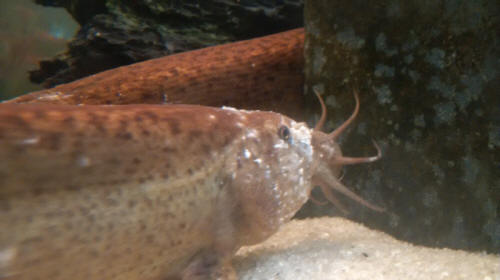
Re: Maybe Not Really Algae 9/4/17
It helps tremendously, thank you!
<Most welcome! Neale.>
|
|
Septicemic Golden Dojo? /Bob's try
8/28/16
Happy Saturday Crew(aside from my loaches),
I recently introduced a group of 30 golden Dojos about a week
ago. They are in a well filtered/established unheated 75g
quarantine tank with airstones, circulation pump and fast growing
floating plants like Salvinia and Nymphoides indica. NH3=0, NO2=0,
NO3=15, temp is 74f.
Upon arrival all looked very good and active but had some ich, which
cleared within a few days but by day 5 I noticed one dojo flashing. It
was close to bed time so I just observed the tank and saw no other
symptoms. By the next morning 6 loaches were near dead with
redness. A few had bright red gills but most had very light red
patches on body with zero fin rot.
I'm starting to see a few more with red and sometimes whites patches on
body. My substrate is fairly immaculate. Any ideas whats causing this or
treatments?
<Yes; either something/s that happened before you received these
Dojos (thermal shock, ammonia burn et al) and/or something/s that are
toxic in this system. Was there life in this tank before? Do you use
chemical filtrants? Other materials on a regular basis; prophylactic
treatments?>
I have noticed the loaches are hauling up on floating plants nearly out
of water, could there be a irritant. I dropped a chop stick in the tank
accidentally for 24hr the day before symptoms showed up but cant see how
it could be related.
Thanks
<Not the hashi... maybe the rock... I'd do a bio-assay (taking some
water, and separately substrate, rock...) and test with a fish, simple
invertebrate in other tanks... For the present Dojos, I'd place a unit
of Chemipure in the filter flow path, and likely a pad of PolyFilter as
well (to hopefully remove whatever is causing the issue here, spiff up
water
quality so the remaining ones might recover. IF I were there day
one, I would have raised the temperature five degrees F. and treated w/
a Furan compound, 25 mg/gal every three days with a water change of
25-50% between each treatment for three rep.s Bob Fenner, who
has seen/lived breakdowns of Dojos several times.>
Septicemic Golden Dojo? /Neale's go
8/28/16
Happy Saturday Crew (aside from my loaches),
<Hello Brandon!>
I recently introduced a group of 30 golden Dojos about a week ago. They
are in a well filtered/established unheated 75g quarantine tank with
airstones, circulation pump and fast growing floating plants like
Salvinia and Nymphoides indica. NH3=0, NO2=0, NO3=15, temp is 74f.
<Understood.>
Upon arrival all looked very good and active but had some ich, which
cleared within a few days but by day 5 I noticed one dojo flashing. It
was close to bed time so I just observed the tank and saw no other
symptoms. By the next morning 6 loaches were near dead with redness. A
few had bright red gills but most had very light red patches on body
with zero fin rot.
I'm starting to see a few more with red and sometimes whites patches on
body. My substrate is fairly immaculate. Any ideas whats causing this or
treatments? I have noticed the loaches are hauling up on floating plants
nearly out of water, could there be a irritant. I dropped a chop stick
in the tank accidentally for 24hr the day before symptoms showed up but
cant see how it could be related.
Thanks
<Loaches don't always ship well. Using antibiotics can be a good
way to pre-emptively treat some of the bacterial infections they bring
with them from the fish farms. Tetracycline is often used with
loaches for external red sores, and that'd be my first suggestion. I'd
also review the tank for any potential sources of poisons, recalling
that Weather/Dojo Loaches are obligate air-breathers, and consequently
as likely to absorb airborne toxins as they are waterborne ones. So
paint fumes are as much a risk as, say, copper-based medications. The
fact the fish are 'flashing' suggests something in the water, whether
chemical (ammonia, copper, etc.) or biological (Velvet is the classic
cause of flashing, alongside Whitespot, though Whitespot is more
immediately obvious whereas Velvet can sometimes attack the gills
without being visible anywhere else). Review, and act accordingly. Good
luck, Neale.>
|
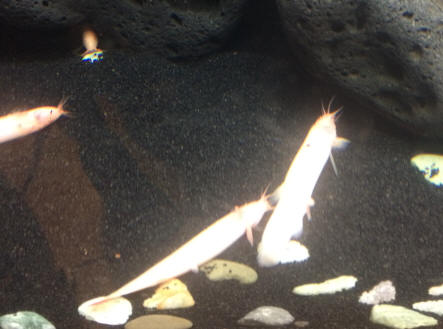 |
|
Re: Septicemic Golden Dojo? 8/28/16
Thanks for the reply back guys. This tank was cycled and had a large Syno in
the tank that was keeping tank cycled but was removed 48hrs prior.
<Ahh>
I did a 50% change this morning and 6 more causalities. What is odd, is they
are developing symptoms so quickly. They've gone from outwardly looking
healthy to very sickly in 24hrs.
<Again; and with more confidence, these fish were challenged ahead
of your receiving them. ALL the fish in that batch are very likely suffering
the same effects>
Can't think of any airborne pollutants or in tank pollutants for that
matter. On top of all that I just purchased a 2nd hand 240g corner unit
looked to be in mint condition and once home I fill tested it and its
leaking like a sieve. Argh
<Yikes! When it rains....>
I do appreciate the feed back. I hope your weekend is better than mine.
Thanks
<Welcome. DO try the Furan/Nitrofuran... it may save some of the Loaches.
Bob Fenner>
|
|
weather loach problem 4/27/16
My weather loach has a problem. I've lost 2 and a 3rd has started to develop
this on his mouth. It appears to be a flesh eating nasty starting in white
crystals then leaving a hole in the skin. It devoured the face of one. All
fish were harmlessly euthanized. The local fish stores had no idea what is
causing this. This has only happened over the last 2 weeks in a well
established tank. Do you have any idea what could cause this , have you seen
it before . Tank parameters are ok. 1000 ltr tank. Temp. 24.3C.
Thank you
<Hard to pin this down precisely, and it may well be viral in origin. It
doesn't look entirely bacterial to me, and more reminiscent of Fish Pox and
Carp Pox, for example. I'm also worried about the substrate though, which is
far too coarse for Weather Loaches, though whether it's the reason the skin
was damaged is hard to say. Water temperature is also a bit high for a
subtropical fish, but again, unlikely to be the immediate cause of the
problem, though conceivably a stress factor that made a viral problems more
likely. I wouldn't rule out heater burns, either, because these fish do have
a tendency to wrap themselves around solid objects at the bottom of the
tank. To be honest, I'd suggest visiting Loaches.com and posting the photos
on their Forum. There might be someone there who has seen this.
Cheers, Neale.>
|
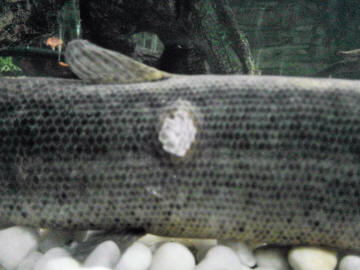
Re: weather loach problem 4/28/16
Thanks for your response, I also have one that has the same except it has
attacked the face destroying the feelers on one side and half the face.
<Glad to offer what help I can... if the folks at Loaches.com come up with a
better diagnosis, let me know! Cheers, Neale.>
|
Follow up question to an old Dojo Loach post
4/22/16
I read an old post on WWM regarding a swollen dojo loach.
<Ahh!>
I was experiencing the same problem and followed the advice Bob Fenner
gave in that post - it worked, and all of my fish are alive now because
of it.
<Yay!>
I really can't thank you for providing this resource. I live in a very
rural area and I am on well water. I had the water tested before I
started up my aquariums and the state lab told me that the water was
pretty much devoid
of everything except calcium. So I've been using Equilibrium by Seachem
to balance the minerals. It seemed to be working, but then about a week
ago all of my weather loaches got bloated and constipated to a certain
degree
with one developing swim bladder issues. I found the post tonight and
followed Bob Fenner's previously posted advice and added 1 level
teaspoon of Epsom salts per 10 gallons of water. That triggered a
"poop-fest" the likes of which I've never seen!
<Heeeee!>
But it was a miracle and all the fish are recovering. But with all that
waste suddenly in the water, I'm going to
have to do at least a 50% water change. Which brings me to my questions;
can I constantly maintain Epsom salts in the tank at a rate of 1
teaspoon per 10 gallons. In other words, every time I do a water change,
can I mix in 1 teaspoon for every 10 gallons of water replaced and
should I continue to use the Equilibrium?
<Yes to using the Epsom; but I'd reduce the amount used by half here>
Any advice you could provide on my situation would
be greatly appreciated!
--
*Life is not about how fast you run or how high you climb, but how well
you bounce. ~Vivian Komori*
*Renee *
<Bob Fenner>
Re: Follow up question to an old Dojo Loach post 4/23/16
Thank you Mr. Fenner - but no opinion on the use of the
Equilibrium?
<Is a worthwhile product... As are all SeaChem's line>
I'm not asking you to comment on the product, but do you feel it is
appropriate for my situation?
<If your source water is mineral deficient... yes. BobF>
Re: Follow up question to an old Dojo Loach post 4/23/16
Thank you! I agree, I love Seachem products. I use the Equilibrium for
my axolotls, who need a harder water, but started using it for the
loaches because of the lack of available minerals in my tap water (based
on lab tests). But I have read that loaches like a softer water and I
was worried I caused their constipation by making their water too hard
for them.
<Ahh! B>
Dojo Loach lump problem. No data, rdg., using WWM
4/11/16
Hi,
<Hayley>
I have searched high and low on the internet to find info on this and
just can't find anything, so hope you can help.
<Me too>
I have a large tank, with a good filter system, contains 2 large
goldfish and 1 loach, I think it is called a Dojo loach, it is the white
and orange coloured one almost see through.
<... Misgurnis anguillicaudatus?>
I have just noticed his body is covered in lumps under the skin, they
are not red and no signs of any rash, he is acting normal and seams
healthy.
They look like they are under the skin more than on top, these are bumps
not spots of any kind, almost look like his skin is bubbling up. There
is no difference in the skin colour or texture where the lump is.
<Oh yes.... you haven't searched on WWM... READ here:
http://www.wetwebmedia.com/fwsubwebindex/DojoHlthF.htm
and the linked files above>
One of our Goldfish we think has a slight case of fin rot,
<Both environmental in origin....>
so we treated the tank yesterday.
<? With what, how? >
I'm not sure if he had the lumps before this or not, but only noticed it
today.
Our tank is very clean, and it is a good quality filter, and the tank is
very large for just the 3 fish.
<This is not useful/data; but subjective statements.... Actual
size, set up, maintenance, water quality measures...>
What could be our problem ?
<Lack of knowledge of use; poor environment at least.... Send
information; but READ first>
Hope you can help,
Thank you
Kind regards
Hayley
<Cheers, Bob Fenner>
|
Sick Weather Loach :(
11/9/15
Hello all!
<Wendy>
First, thank you so much for your amazingly helpful website. I have read through
so many threads & clicked & read as many links as I could find which I'd hoped
would help (so I wouldn't have to bother you) but I could not find something
that sounded exactly like our situation, so I thought I'd write to you for help.
<Real good>
Here's what we've got:
10 gallon tank (am working on hubby to allow us a 30 gallon tank��)
<Good; much easier to keep stable; more fun to stock, keep>
Set up for nearly one year
6 guppies
Two 4" weather loaches
One 2" weather loach
Small Pleco
<Mmm; this last... you might want to find out what/which species this is... Many
commonly sold get VERY large, and they can/do go after other fishes at times>
Temp 76-78
Nitrites are zero but I've been having issues with the nitrates getting slightly
higher than zero
<Mmm; I would not be too finicky re this NO3 under 10-20 ppm are rarely of
consequence>
so from now on I have told my son that I will be doing the feeding, not him as I
can't regulate it
Ph is in 6.5-7.5 range
Hard water
I vacuum the rocks every Sunday & do a 25% water change & add Prime. I also
rinse out the filter very well at weekly cleaning & change it & add new charcoal
monthly.
<Good>
Feed a mix of shrimp pellets (2-4 per day) & some Tetra flakes, the harder kind
that don't break up so easily, twice a day. I estimate about 85% of the food is
eaten within 30 seconds then the fish pick at the rocks for any remaining
tidbits. I think we have been feeding too much but I feel so bad when the fish
are all like YOU MUST FEED US!!!! whenever they see us enter the room. :)
<Heeee!>
We have had the sick loach about 4 months, & up until 2 weeks ago, he was very
lively & funny, a good eater, typical "weather warning" behavior. I began to
notice two patches of whitish, funny looking skin, one directly behind his head
& the other further back on the side of his body. (Coincidentally during this
time, the baby loach (newest addition about 6 weeks ago) "lost" his whiskers. I
didn't notice anyone picking on him but am wondering if a fungus could have
dissolved them?
<Mmm; possibly>
Anyway, Orangey, the sick loach, began swimming oddly, kind of uncontrollably &
swimming upside down at times. The area behind his head seemed stiff as though
he felt pain while swimming & that's why he swam stiffly. :( I consulted the
fish store who told me to begin using Melafix.
<Mmm; no; not a fan>
On day 5 of treatment, his white patches were much better & this one female
guppy who had previously picked at those spots stopped doing so. He is still
swimming stiffly & seems to not be able to control his direction - he's kind of
spastic. :-/ (That being said though, he is swimming better that he has the last
2 weeks.) He used to eat food from the top of the water (or was he getting air
as well?) & he has begun swimming at the top again but not very gracefully.
I have been reading & reading your site for literally hours. Today I vacuumed
again, changed about 40% of the water, added Prime & Stress Zyme as well as 12
teaspoons of Epsom salts. I also added a 6" long bubble stone in the hopes the
extra oxygen will help him.
<All good moves>
So, after reading a thread about a loach with red dots, I started looking at
Orangey more carefully. He has always been a very deep orange whereas the other
two are more whitish (Ghosty & the baby Speedy is somewhere between the two
extremes). So I am including a picture of Orangey but I really can't determine
if his coloring is different or if those truly are red dots signaling a
bacterial infection?
<Latter; and more likely environmental stress first; bacterial secondarily>
His dorsal fin is also reddened & does not fan out anymore either - could that
be part of the swimming issues?
<More like "the breed"; what they do>
I do feel he is on the mend but as I don't know what else to do for him, I felt
I should ask you. I realize it is probably overcrowded & soon I really hope to
get the 30 gallon tank so that the eels can be safe & happy.
<Yes; the switching to the larger system is exactly what I'd do; moving all the
existing substrate, filter/media.... and water in the ten gallon to it>
Thank you for any advice you can offer as to Orangey's issues as well as
Speedy's missing whiskers. :)
Sincerely,
Wendy Letter
WICHITA KS
Both pictures are of Orangey. The bottom picture better shows the red dots -
though only visible if you zoom wayyyy in. His dorsal fin is a bit reddened &
does not fan out like the others'. He is eating ok but I feel he has a hard time
finding food because of his swimming issues. :(. The white patches are now gone
- you can kind of see the patch right behind his head - in the bottom picture -
it looks like it has healed.
Thank you again!!!! :)
<My best guess is that the whisker loss, petecchia, anomalous swimming behavior
are resultant from the environment vacillating too much.... your fastidious
attention to "cleanliness" working against you here. How to put this: there is a
fine line twixt out captive systems becoming "too polluted" and the benefits of
having them be "more stable" by not cleaning, changing much water too often too
much... For now I'd ease back on the gravel vacuuming and only change no more
than 20-25% of the water at any given time.... And DO save up for that larger
system. I would NOT treat the water; would discontinue homeopathic remedy use.
Bob Fenner>
|
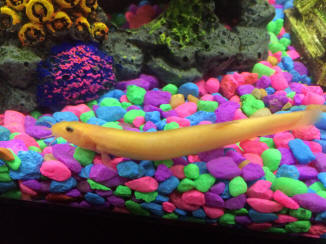
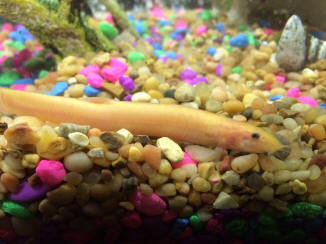
Sick Weather Loach :(
Neale's Independent Input 11/10/15
Hello all!
<Hello Wendy,>
First, thank you so much for your amazingly helpful website. I have read through
so many threads & clicked & read as many links as I could find which I'd hoped
would help (so I wouldn't have to bother you) but I could not find something
that sounded exactly like our situation, so I thought I'd write to you for help.
<Cool.>
Here's what we've got:
10 gallon tank (am working on hubby to allow us a 30 gallon tank��)
<Indeed; while perhaps not the immediate problem, this will be exacerbating any
underlying problems. Do bear in mind there's no such thing as a "small" Plec,
they're only juveniles. Adults are 12-18 inches long, and get to 10-12 inches
within the first year. Big fish. Need something like 55-75 gallons, minimum.>
Set up for nearly one year
6 guppies
Two 4" weather loaches
One 2" weather loach
Small Pleco
Temp 76-78
Nitrites are zero but I've been having issues with the nitrates getting slightly
higher than zero so from now on I have told my son that I will be doing the
feeding, not him as I can't regulate it
<Nitrates will never be zero. But ammonia and nitrite must be zero at all
times.>
Ph is in 6.5-7.5 range
<That's a hell of a range! In seriousness, pH 6.5 is slightly acidic. Fine for
Plecs, not that nice for Weather Loaches, which prefer around neutral to
slightly basic, and positively harmful to Guppies, which need fairly basic
water, pH 7-8, to do well. More to the point, if it varies between these two
extremes, there's something amiss. Tanks tend to become acidic over time, so the
usual thing is your tap water has a pH of, say, 7.5, but that drops to pH 7 just
before you do a water change.>
Hard water
<Good.>
I vacuum the rocks every Sunday & do a 25% water change & add Prime. I also
rinse out the filter very well at weekly cleaning & change it & add new charcoal
monthly.
<Carbon is largely redundant. In an aquarium like yours, more biological media
is better.>
Feed a mix of shrimp pellets (2-4 per day) & some Tetra flakes, the harder kind
that don't break up so easily, twice a day. I estimate about 85% of the food is
eaten within 30 seconds then the fish pick at the rocks for any remaining
tidbits. I think we have been feeding too much but I feel so bad when the fish
are all like YOU MUST FEED US!!!! whenever they see us enter the room. :)
<They have you well trained. Do resist. Most fish benefit from underfeeding
(relative to what we think they need). A rule of thumb: a portion about 1-2
times the size of a fish's eye is about right per day.>
We have had the sick loach about 4 months, & up until 2 weeks ago, he was very
lively & funny, a good eater, typical "weather warning" behavior. I began to
notice two patches of whitish, funny looking skin, one directly behind his head
& the other further back on the side of his body. (Coincidentally during this
time, the baby loach (newest addition about 6 weeks ago) "lost" his whiskers. I
didn't notice anyone picking on him but am wondering if a fungus could have
dissolved them?
<Your gravel did it! Long story short: coarse, sharp gravel damages the whiskers
of catfish and loaches. Bacteria get into the wounds, and cause them to decay.
It's basically Finrot but affecting the whiskers rather than the fins. Choose a
fine, smooth pea gravel, or better still, a thin bed of lime-free sand. You
presumably don't have live plants (the Plec will take care of them in time if
you do!) so a half-inch of sand is fine. Just use floating plants and/or
epiphytes attached to bogwood roots (Java fern and Anubias for example) instead.
Lime-free sand is cheap and cheerful if you use stuff like pool filter sand.>
Anyway, Orangey, the sick loach, began swimming oddly, kind of uncontrollably &
swimming upside down at times. The area behind his head seemed stiff as though
he felt pain while swimming & that's why he swam stiffly. :( I consulted the
fish store who told me to begin using Melafix. On day 5 of treatment, his white
patches were much better & this one female guppy who had previously picked at
those spots stopped doing so. He is still swimming stiffly & seems to not be
able to control his direction - he's kind of spastic. :-/ (That being said
though, he is swimming better that he has the last 2 weeks.) He used to eat food
from the top of the water (or was he getting air as well?) & he has begun
swimming at the top again but not very gracefully.
I have been reading & reading your site for literally hours. Today I vacuumed
again, changed about 40% of the water, added Prime & Stress Zyme as well as 12
teaspoons of Epsom salts. I also added a 6" long bubble stone in the hopes the
extra oxygen will help him.
So, after reading a thread about a loach with red dots, I started looking at
Orangey more carefully. He has always been a very deep orange whereas the other
two are more whitish (Ghosty & the baby Speedy is somewhere between the two
extremes). So I am including a picture of Orangey but I really can't determine
if his coloring is different or if those truly are red dots signaling a
bacterial infection? His dorsal fin is also reddened & does not fan out anymore
either - could that be part of the swimming issues?
I do feel he is on the mend but as I don't know what else to do for him, I felt
I should ask you. I realize it is probably overcrowded & soon I really hope to
get the 30 gallon tank so that the eels can be safe & happy.
Thank you for any advice you can offer as to Orangey's issues as well as
Speedy's missing whiskers. :)
<Hard to say from your photos what the issue is you're describing. But in short:
these are a tank-bred form of Weather loach and colouration does change with
time. Brown and pink patches are not uncommon. However, anything that looks like
red blood vessels, perhaps like an inflammation, is bad. That's often the first
sign of infection. Weather loaches have tiny scales and mostly rely on mucous to
keep their bodies free of bacteria. Anything that rubs off the mucous, such as
gravel, weakens that defence (which, remember, has evolved to work in muddy
habitats, not gravelly ones). Make sense?>
Sincerely,
Wendy
Both pictures are of Orangey. The bottom picture better shows the red dots -
though only visible if you zoom wayyyy in. His dorsal fin is a bit reddened &
does not fan out like the others'. He is eating ok but I feel he has a hard time
finding food because of his swimming issues. :(. The white patches are now gone
- you can kind of see the patch right behind his head - in the bottom picture -
it looks like it has healed.
Thank you again!!!! :)
<Hope this helps, Neale.>
|
:( Orangey Eel much Worse /RMF
11/12/15
Hi All,
<Wend>
Thank you for offering some perspective on Orangey the eel.
<Am sending this to Neale his resp. as well>
Sadly last night, I took this photo & noticed a new area of discoloration behind
his pectoral fin. Within 24 hours this area became whitish & sloughing off,
mucous or skin floating off from it. There is also an area on the opposite side
of the body which almost looks like a crack in his body & white flesh or skin
coming out. I could not get a good photo of it, however, after reading
through your site again, it sounds like Costia or Slime Disease.
<Not necessarily; no... most likely physical damage... reaction>
I can't find what treatment is safe for dojo eels - I think I read
something about copper as a treatment but it is not safe for dojo eels & I
really don't want to treat him with something unless it is safe.
<No to copper... poisonous more than helpful. Perhaps Maracyn/Erythromycin will
be safe and possibly helpful>
I don't know if he'll make it through the night but if he does, I will try &
find treatment for him. The female guppies were back at nibbling at him - can't
think why unless they sense he is close to becoming a food source :(
I put a small colander upside down in the tank and put him in it so at least he
will not be bothered :(
<Good>
What risk does this disease pose to the rest of the fish as well, & especially
since the guppies are pecking at him?
<Close to zero>
Was it brought in by the new eel or Pleco? Or did I cause this to happen from
trying to keep the tank too clean?
<.... can't say. The only sure means of such assessments is sampling and
examining under a microscope>
Thank you so much for your assistance!
Wendy Letter
<Don't panic. Bob Fenner>
:( Orangey Eel much Worse
/Neale 11/12/15
Hi All,
Thank you for offering some perspective on Orangey the eel.
<Loach. He's a loach!>
Sadly last night, I took this photo & noticed a new area of discoloration behind
his pectoral fin. Within 24 hours this area became whitish & sloughing off,
mucous or skin floating off from it. There is also an area on the opposite side
of the body which almost looks like a crack in his body & white flesh or skin
coming out. I could not get a good photo of it, however, after reading
through your site again, it sounds like Costia or Slime Disease.
<Possibly, but do understand that simple physical damage causes similar
symptoms. Inflammation, dead white skin or fin tissue...>
I can't find what treatment is safe for dojo eels - I think I read
something about copper as a treatment but it is not safe for dojo eels & I
really don't want to treat him with something unless it is safe.
<Loaches. Look up stuff safe for loaches. Basically, salt/heat, antibiotics.
Formalin and copper highly toxic. Organic dyes (such as malachite green and
Methylene blue) somewhat variable in safety. The good folks at
Loaches.com are your best bet here. Tell them what's available locally or online
in your country, and they'll be able to help. I'll tell you that in the UK, I'd
recommend eSHa 2000 as a safe bet. Generally works nicely with all but the most
sensitive species (stingrays for example).>
I don't know if he'll make it through the night but if he does, I will try &
find treatment for him. The female guppies were back at nibbling at him - can't
think why unless they sense he is close to becoming a food source :(
I put a small colander upside down in the tank and put him in it so at least he
will not be bothered :(
<Hmm... may well drown. Obligate air breather: must be able to gulp air.
Instead, try isolating/removing the Guppies.>
What risk does this disease pose to the rest of the fish as well, & especially
since the guppies are pecking at him?
<None.>
Was it brought in by the new eel or Pleco? Or did I cause this to happen from
trying to keep the tank too clean?
<Almost certainly caused by trying to burrow into sharp gravel or else physical
damage caused by Plecs (which sometimes "rasp" at tankmates if they're hungry).>
Thank you so much for your assistance!
Wendy
<Welcome. Neale.>
|
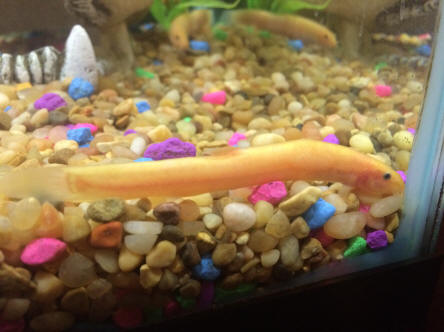 |
|
|
|

